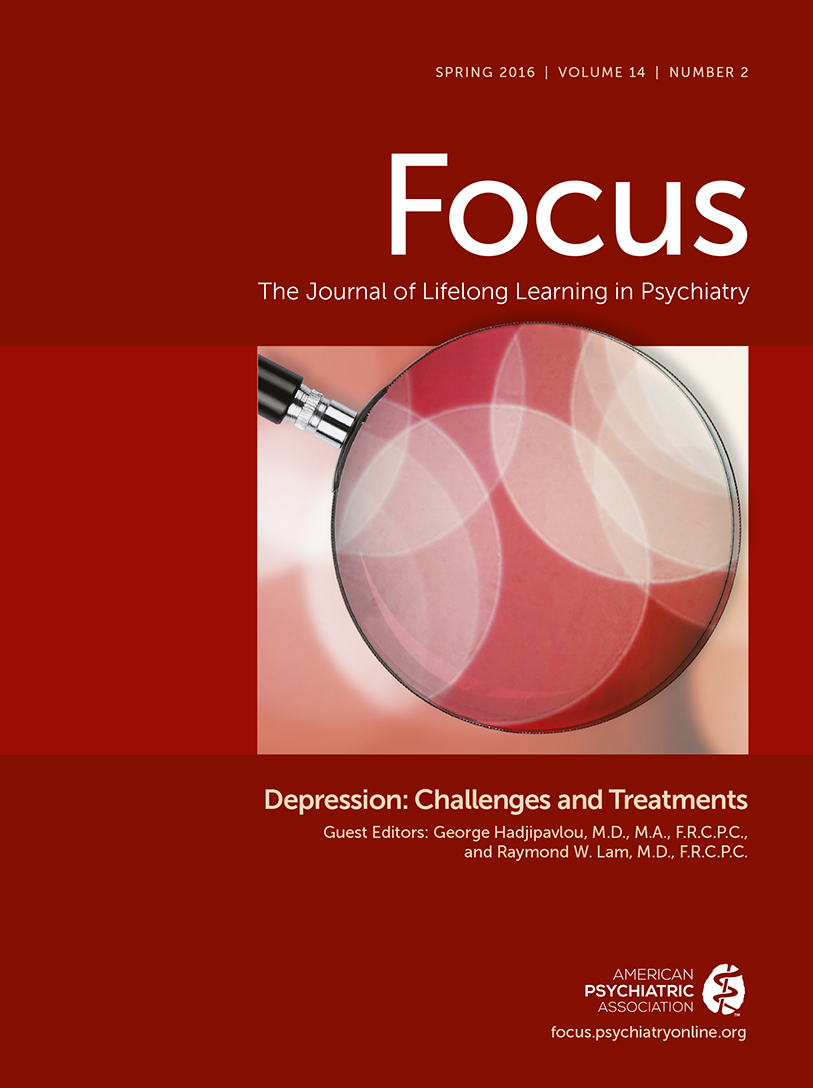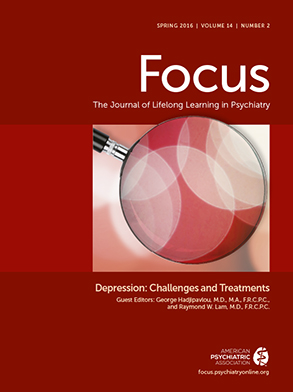By far the greater number of aeroplane accidents are due to precisely the same circumstances that have caused previous accidents. A distressing feature of these accidents is the evidence they afford of the unwillingness, or the inability, of many pilots to profit from the experiences and mistakes of others.
—
Gustav Hamel and Charles C. Turner, 1914 (
1)
Decreasing suicide rates through health care system change is an example of how improving patient safety warrants psychiatrists’ awareness, training, teamwork, and leadership in system-based solutions.
It has been over 15 years since the Institute of Medicine (IOM) report,
To Err Is Human: Building a Safer Health System (
2), reported that “at least 44,000 people, and perhaps as many as 98,000 people, die in hospitals each year as a result of medical errors that could have been prevented.” In March of 2001, IOM’s next catalyzing report,
Crossing the Quality Chasm, concluded that “merely making incremental improvements in current systems of care will not suffice.” These reports inspired the nation’s campaign to improve quality and safety in health care (
3). However, adverse events causing morbidity and mortality continue. The Six Sigma comparison of industries ranks the many health care “defects per million opportunities” near that of the Internal Revenue Service tax advice phone-in service; domestic airline flight fatality rates achieve superior Six Sigma safety rates (
4).
Many of the country’s top sentinel events are mental health related, including restraint-related events, elopements, self-inflicted injuries, and suicides (
5). Some of the top sentinel event settings include psychiatric hospitals, psychiatric units, and behavioral health facilities, totaling 19% of all locations for sentinel events since 2004. In comparison, emergency departments account for only 5.4%, and office-based surgery, 0.9%. Approximately 1,500 inpatient suicides occur per year in the United States (
6). In juxtaposition, the most recent data from aviation fatalities from the National Transportation Safety Board reveal a total of only 443 aviation deaths (
7). If psychiatrists are the pilots of the mental health system, then what can they do in collaboration with others to transform the industry to the next level of safety at a systems level?
Many organizations support this system transformation, including IOM, the Agency for Healthcare Research and Quality, the Joint Commission, the American Academy of Child and Adolescent Psychiatry, and the American Psychiatric Association. In addition, the American Board of Medical Specialties is highlighting safety standards by integrating patient safety principles into its program for maintenance of certification (MOC) requirements (
9). The American Board of Psychiatry and Neurology is part of this leadership drive (
10).
Focus will begin attending to MOC safety requirements and providing a review of current clinical safety practice.
Patient safety is a vital function of psychiatric services and a core objective of the mental health system. Without safety, there would be neither treatment nor recovery. Suicide is one of the top safety challenges that our health care system faces. Psychiatrists and other mental health clinicians practice standards of care in their provision of suicide risk assessment, risk management, and biopsychosocial treatments. However, in the system of care some failure modes are root causes of suicide and are beyond the realm of the psychiatrist’s assessment and treatment.
If there were board exam questions on suicide data and suicide risk assessment, psychiatrists would readily know the answers (noted at the end of this column):
1.
True or False? Suicides are the tenth leading cause of death for all ages (
11).
2.
True or False? Homicides outnumber suicides in the United States and the world (
12).
3.
True or False? Suicides cost with lives but also with dollars, with an estimated $51 billion in combined medical and work-loss costs (
13).
4.
The number one cause of litigation (
14) for psychiatrists is
A.
Tardive dyskinesia secondary to first-generation antipsychotics
B.
Failure to abide by Tarasoff Laws—duty to warn and protect—associated with violence and homicides by persons with mental illness
Although psychiatrists cannot always prevent suicide, suicide risk assessment is a vital dimension of suicide prevention. Several superb resources exist for clinicians that guide best-practice suicide risk assessment. The exam question might read as follows:
5.
Suicide risk assessment and risk management include all of the following components except
A.
Evaluation of suicidality
B.
Elicitation of dynamic and static suicide risk factors and risk reduction factors
C.
Input from all available resources (e.g., patient, family, other caregivers, and medical records)
D.
Formulation that rationally pulls together the data and estimates risk as low, moderate, or high in the near future
F.
Biopsychosocial treatment plan that mitigates dynamic, modifiable risk factors, strengthens risk reduction and resiliency factors, and develops a relapse prevention plan
These suicide risk assessment and management skills are taught during psychiatrists’ first years in medical school. However, knowledge of these data and competencies in suicide risk assessment alone does not necessarily decrease the likelihood of suicide for the patient. Supporting psychiatric services toward zero suicide rates requires a systemic approach. Clinically focused suicide risk assessment is one component. Getting the system closer to zero suicides will require an organized approach, as exemplified by the efforts of the Suicide Prevention Resource Center’s Zero Suicide Initiative (
15) and the reported successes of the Henry Ford Health System (
16). What are the other system factors that organizations can target to support clinicians?
Although failures in clinical assessment are a top root cause of suicide events, many of the underlying root causes are not primarily clinically based. Root causes of suicides include not only failures in assessment but also failures in communication, human factors, leadership, physical environment, information management, and the continuum of care (
17). Some of these factors are beyond the direct control of a physician’s order or scope of practice, including staffing levels, in-service education, organizational culture, community relations, and even hand-off communication for colleagues across shifts and transition of care. With the continued failures in the detection and treatment of persons with suicidal ideation in all health care settings and nearly 1,100 reports of sentinel events from suicide occurring from 2010 to 2014, the Joint Commission issued in February 2016 a new
Sentinel Event Alert “Detecting and Treating Suicide Ideation in All Settings” (
http://www.jointcommission.org/assets/1/18/SEA_56_Suicide.pdf), which aimed to improve screening, risk assessment, safety, treatment, discharge, and follow-up care recommendations for at-risk individuals.
How can psychiatrists support a health care system that improves safety—not only safety for the persons served, but also a system of safety to support the clinicians’ provision of care? The field is moving, therefore, to the next level of improvement by empowering psychiatrists with the skills to lead transformation. Topics of focus for MOC will include increasing patient safety awareness, establishing a patient safety culture, epidemiology of errors and safety, and strategies for engaging executive and clinical leaders in safety (
18). These efforts will help psychiatrists transform both individual practice and our system to improve patient safety for the people served and for the clinicians providing the care.
6.–9. Further aspects of training include knowledge of the means to improve safety systems. Match the safety practice approach that best fits with the describing characteristic:
____6.
Its five components include (a) trust—high levels of (measured) trust exist in all clinical areas, and self-policing of codes of behavior is in place; (b) accountability—all staff recognize and act on their personal accountability for maintaining traditions of safety, and equitable and transparent disciplinary procedures are fully adopted across the organization; (c) identifying unsafe conditions—close calls and unsafe conditions are routinely reported, leading to early problem resolution before patients are harmed, and results are routinely communicated; (d) strengthening systems—system defenses are proactively assessed, and weaknesses are proactively repaired; (e) assessment—measures are part of the strategic metrics reported to the board, and systematic improvement initiatives are under way to achieve a fully functioning safety ethos (
3).
____7.
Evolved within the Toyota Motor Company, “the true focus … is on evolving to a state in which work processes relentlessly emphasize eliminating waste. Waste is defined as acts that do not add value to customers and includes wasted resources, time, and human spirit.” In hospital settings, these “principles were introduced as a tool for ensuring safer care rather than cheaper care” (
19).
____8.
A model to improve safety includes ADKAR: Awareness of the need for change; Desire to participate and participate in the change; Knowledge of how to change; Ability to implement required skills and behaviors; Reinforcement to sustain the change (
21).
____9.
Although some have perceived this safety methodology as having barriers and shortcomings in its adaptation from Motorola and General Electric to health care (
22,
23), this complex process improvement strategy is deployed in five phases—DMAIC (Define, Measure, Analyze, Improve, and Control)—that are rigorously followed whenever a problem, large or small, is addressed. The disciplined, data-driven approach helps an organization eliminate defects, moving processes or products toward quality of near perfection (
24), including superior safety levels.
If psychiatrists are the pilots in behavioral health care, now is the time to move to the next level in gaining the skills to team with the “mechanics, engineers, and checklist makers” to make psychiatric services “air worthy.” On January 15, 2009, Captain Chesley B. “Sully” Sullenberger III and First Officer Jeffrey B. Skiles made an unpowered emergency landing of US Airways Flight 1549 onto the Hudson River. All 155 passengers and crew survived. As the partially submerged airplane sank slowly into the river, all were rescued. The heroes were not only the pilots but also the people behind the scene, including those who built the quality and safety systems (
20). Similar acts of heroism are needed every day in striving toward a safer mental health system.
Answers
1, True; 2, False; 3, True; 4, D; 5, E; 6, C; 7, A; 8, D; 9, B (Six Sigma aims to have processes for which the measured mean is at least statistically 6σ (six sigma) away from the nearest specification limit, that is, 6 standard deviations between the process mean and the nearest specification limit. In a Six Sigma process, 99.99966% of all opportunities to produce some outcome of a process are statistically expected to be free of defects—i.e., safe for the patient—achieving no more than 3.4 defects per million opportunities [
21]).

